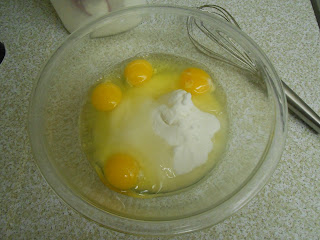Up first is a recipe from our Grandma Carper, our mom's mom. I was 10 when she died, so my perception may be a little warped, but I remember her as the epitome of fashion and style. All of my fashion genes were passed directly from her, and she is also where I get my love of shopping, shoes & coats (hate wearing them, love buying them!). The picture below was taken about a month before she died, on a vacation to Orlando. The dress and shoes I'm wearing were hers, but I remember feeling so grown up and sophisticated in that outfit. A fun fact, my Grandma wore a 7 1/2 shoe...at 10, I was wearing a size 10 (and my feet were not done growing :/ ). I wore the shoes despite how much they hurt my feet!
Like I said, simple ingredients...Butter, cocoa powder, flour, sugar, eggs & salt.
First, preheat your oven to 350°. No seriously, go do it now. I always forget which slows down the baking process an extra 10-15 minutes.
In a small saucepan, melt the butter. One great thing about this recipe is that the butter does not have to be thawed. If you have it stored in the freezer, just take it out and throw it in the pan!
Once it has melted, add the cocoa powder and stir it together. Set the mixture aside.
In a medium-large bowl, cream together eggs and sugar. You could use an electric hand mixer for this or just a whisk. It's not a labor intensive process, so I usually go for the whisk (especially when the beaters for the mixer are in the dishwasher, which mine were :)
Add the flour and salt and mix together.
Carefully beat in the chocolate/butter mixture. This can get a little messy if you aren't careful. I also like to use a glass bowl for this so I make sure the chocolate is mixed all the way through the batter.
Mmmm...yummy! This is the hardest part of this recipe. You have to get the batter from the bowl, to the pan, without eating it all first. Good luck to you!
Pour it into a greased pan. The recipe says 9x13, but it depends on what you want to use it for. If I'm just making plain or frosted brownies, I prefer a smaller pan so that they are thicker. But, if you want to add other deliciousness on top of it, you might want them thinner. You could also use muffin or mini muffin pans (just be sure to adjust the baking time).
Bake for 40 minutes (or until toothpick inserted in center comes out clean).
The finished result! Remove from the oven and let them cool. (Oh, who am I kidding? Eat them straight out of the oven and burn your friggin' mouth off - like I did!)
Comment and let me know what you think and/or if you try these yourself!
Grace and love,
Jenn













































.JPG)
.JPG)
.JPG)

.JPG)

